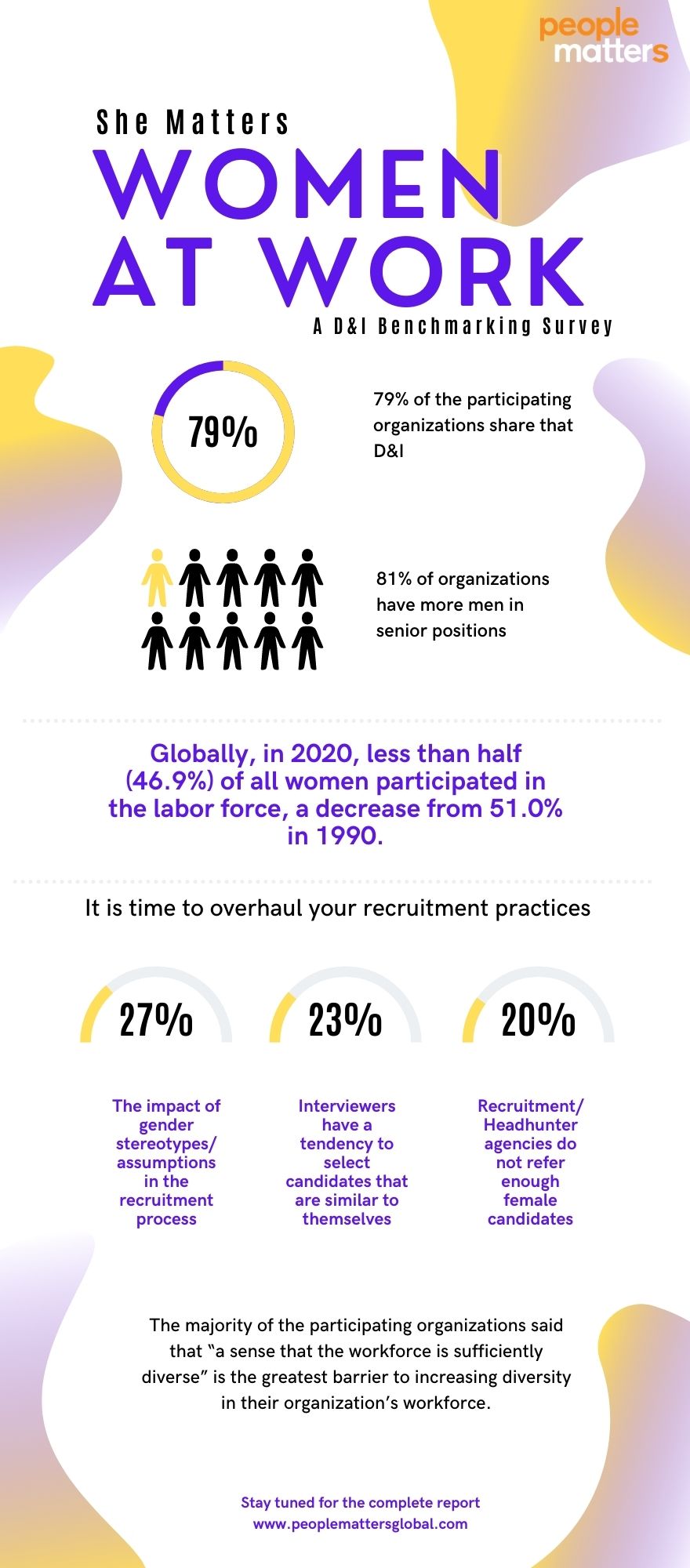Time to set the gender quotient right: People Matters Study on D&I

In the wake of major social and political changes over the past decades, leading companies are taking steps to increase diversity, equity, and inclusion. According to a number of researches, we have found that diverse companies outperform with more homogenous demographics, have lower volatility, a better return on equity, and a higher degree of creativity and cognitive conflict during the decision-making process.
While organizations around the world understand the need for diversity and are putting efforts to create a more diverse and inclusive workplace, the progress doesn’t seem to be much. Programs designed to increase diversity and inclusion in the workplace often fail.
She Matters, an annual campaign by People Matters that aims at enabling organizations to help their women employees to thrive and be empowered at work, brings this first edition of the She Matters: Women at Work – D&I Benchmarking Survey which is aimed at benchmarking the efforts of organizations, measuring what’s working and what’s not, and put forward a report on where are we on the journey of creating an equitable workplace for our women employees.
The survey that was launched earlier this month, saw participation from 256 unique organizations, predominantly from India, Singapore, the Philippines, Thailand, Malaysia, Indonesia, and Australia among others.
A number of studies have been conducted in the space of Diversity & Inclusion with a focus on how employers and women can break the glass ceiling. There is no dearth of knowledge when it comes to ‘creating an equitable workplace’ but we feel it is absolutely imperative to know what’s working and what’s not. The study benchmarks some of the key areas of equitable workplaces, understand what are some of the practices that organizations need to think and plan differently, and the need to augment the practices and policies which are really working.
The final study is awaited to get launched next month in April, where organizations can download the full report along with the key action items to creating a balanced workplace. As we close our theme for the month of March, #ChooseToChallenge, here are the key insights from the study.

D&I is a priority for organizations with men holding key positions in over 80 percent of the organizations
79 percent of the participating organizations share that D&I is a priority for their business; however, they also shared that most of the senior positions are held by men in their organizations. Further, 59 percent of the organizations do not have a strategy in place and/or programs specifically aimed at developing women leaders.
It is time to overhaul your recruitment practices and business: Barriers to hiring more women at the workplace
Over 60 percent of organizations do not have a gender-balanced workforce with over 60 percent of organizations having less than 50% of women in the current workforce. When asked about what are some of the most significant barriers to increased levels of female experienced hires, 44 percent of the participating organizations share that there is a lack of a sufficient candidate pool. 35 percent of participating organizations share that their industry sector is not viewed as attractive to women.
However, one of the stark findings and a reality that was accepted by these organizations was a gap in the existing recruitment process:
- The impact of gender stereotypes/assumptions in the recruitment process: 27%
- Interviewers have a tendency to select candidates that are similar to themselves: 23%
- Recruitment/Headhunter agencies do not refer enough female candidates: 20%
Further, 20% of participants shared that their organization is not actively doing enough to attract and recruit women.
Have we fared in our progress? Not until we come out of our bubble of doing it right
Even before the pandemic, the global labor force participation rate was declining for both women and men. However, across the world, women are less likely to participate in the labor force than men. Globally, in 2020, Less than half (46.9%) of all women participated in the labor force, a decrease from 51.0% in 1990.
In our survey, we found more than diversity being an HR challenge, it is a mindset challenge. The majority of the participating organizations said that “a sense that the workforce is sufficiently diverse” is the greatest barrier to increasing diversity in their organization’s workforce. Further, “General attitude of indifference,” and “Lack of top-level commitment” turned out to be the biggest hurdles to making progress in D&I initiatives.
However, in about 43 percent of organizations, D&I is the responsibility of the Human Resources and/or the Diversity & Inclusion Program officer. D&I has to have a cross-functional team and it doesn't mean a cross-functional team within HR. Make sure when you build a D&I team in your organization, it has people across different roles and levels. That's how you are going to build the true culture sustainably.
Key reflections
Organizations around the world understand the need for diversity and are putting in efforts to create a more inclusive workplace. However, programs designed to increase diversity and inclusion in the workplace often fail. For example, most organizations still struggle with unconscious biases interfering with recruitment decision-making - even those with the most sophisticated recruitment technologies in place.
Organizations need to be cognizant about the support that women would require in different phases of their life – marriage, maternity, family responsibilities. And they would have to put more effort to make the interventions and processes work.
Managers and leaders would have to offer support, confidence, and visibility besides a number of programs and interventions to really make the D&I programs work.
Stay tuned for the launch of the full industry-wide benchmarking report.
















